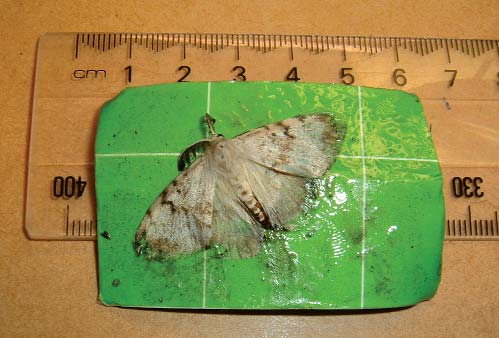PESTS AND DISEASES OF FORESTRY IN NEW ZEALAND
Gypsy moth Lymantria dispar, 2003
From Biosecurity 43, May 2003.
A single male gypsy moth was caught in Hamilton in late March, demonstrating the value of MAF’s gypsy moth trapping programme.

The catch was the first made since the trapping grid was put in place 10 years ago as an early warning system, and immediately triggered a ‘full alert’.
As at the first week of April no further gypsy moths had been found, either through daily trap inspections or ground searches, and an intensified trapping programme was in full swing.
More than 400 traps had been placed out to a 7 km radius of the catch site. In addition, 75 traps had been placed at distances up to 30 km away on main arterial routes as a precautionary measure, and 1200 new traps and pheromone lures had arrived from Canada for contingency purposes.
A technical advisory group was scheduled to meet in Hamilton on 30 April and good support for MAF’s response was being received from the Hamilton City Council, the regional council, Environment Waikato and stakeholder groups.
Peter Thomson,
Director MAF Forest Biosecurity
Gypsy moth update
From Biosecurity 44, June 2003.
As of 20 May 2003, no further evidence of the gypsy moth has been detected.
Daily inspection of the pheromone traps was completed on 14 May 2003. As a precaution, traps will remain in the field over winter and will continue to be checked every 2-4 weeks.

The Technical Advisory Group met for the first time on 30 April 2003. Recommendations were developed for short-term (over winter) strategic
actions. This will involve intense ground searching around the epicentre for evidence of egg masses, pupal skins and webbing. Less intense ground searching will be carried out in outer zones. In addition, traps will remain in the field, movement controls will continue to be enforced, and the public awareness campaign will be enhanced.
Longer-term strategic actions were discussed and options around actions (e.g. mass trapping, aerial spraying, ground spraying, host removal) in spring are still being considered.
DNA profiling continues to determine the exact strain of gypsy moth. To date there is very good evidence that the trapped moth is of Japanese origin, i.e. Asian biotype.
The Controlled Area has been determined and communicated to the Hamilton public via the Waikato Times and local radio. Restrictions have been placed on the movement of all plant matter (except lawn clippings) from the greater Hamilton area. Disposal of vegetative material is permitted at three dumpsites that fall within the Controlled Area.
Compliance agreements and special permits have been issued to nurseries, commercial growers and the like who fall within the Controlled Area so that
they can move treated plant material outside the Controlled Area.
Peter Thomson,
Director MAF Forest Biosecurity



